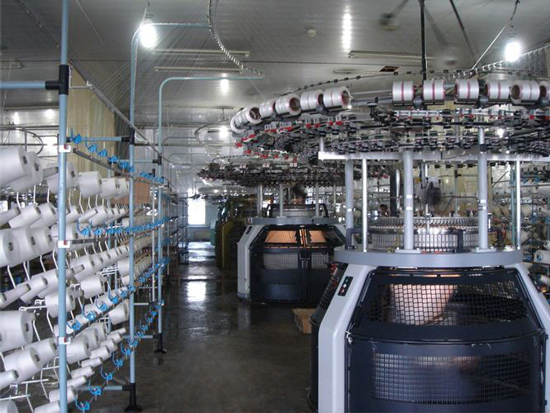VFD for circular knitting machine
I. Overview
This article ATO summarizes how to apply and debug the VFD for the circular knitting machine in one textile mill. ATO chooses the non-inductive vector VFD. It adopts current vector control. Its precise control as well as the characteristics of low-frequency stability and large torque, realizing the functions of big starting torque, stable operation, quick stop and so on of the circular knitting machine. The circular knitting machine is mainly used to knit various raising knitted fabrics, T-shirt fabrics, decorated fabrics with eyelets. According to the different structure, it can be divided into single jersey series and double jersey series.
II. Control scheme
At present, the circular knitting machine has a rather matured control system, which basically adopts microcomputer single chip or PLC + human-computer interface to control, with the direct communication control between the touch screen and VFD. Because of the problem of the field environment, the touch screen is easily to have the faults. Therefore, in normal conditions, connecting the microcomputer with the VFD is the mainstream approach. This time, ATO VFD adopts the microcomputer controller for the connection and control in the site. As to the control frequency, it is required that the VFD can provide a rather big low-frequency torque, because the load is heavy in weaving or the temperature is low. Inching the dynamic response must be quick. Here, ATO VFD adopts the speed sensorless vector control mode, so as to improve the speed stabilizing accuracy and the low-frequency torque output of the motor.
The circular knitting machine requires the motor to forbid the reversal and rotation phenomena, otherwise the needle of the needle bed will be bent and even broken. As to the circular system with unilateral bearing, the influence of this aspect can't be considered. If the positive and negative rotation of the system all depends on the motor control, attentions must be given to adopt the DC braking function properly and considerations must be given to add the braking resistance or not. As to the speed control, the system is required to operate at three-section speed at least. First is the inching operation, with the frequency of 5-6Hz. Second is the normal high-speed weaving operation, with the maximum frequency reaching 80Hz. Third is the low-speed cloth collecting operation. When the cloth is in a certain length, it is required to collect the cloth at a low speed of around 20Hz.
However, as to the multi-step speed control, at present, there are basically two controlling schemes. The first scheme is to utilize the analog quantity preset frequency. No matter in inching, high speed or low speed operation, the analog quantity signal and operating command are given by the control system. The other scheme is to utilize the built-in multi-step frequency preset of the VFD. The control system will give the multi-step frequency switch-over signal while inching is also provided by the built-in inching function of the VFD itself. In high-speed weaving, the set frequency is given by the analog quantity or the VFD setting frequency. The field control mode is MS-031 microcomputer controller and VFD connection. The setting frequency of the VFD is given by the microcomputer controller voltage (0-10V voltage signal).
III. Parameter setting
The circular knitting machine doesn't have high control requirements to the VFD. Employing V/F control can satisfy the requirements thoroughly.
Parameters setting in the site:
| Function code | Parameter setting | Instruction |
| P0.01 | 5 | 0-10V frequency setting |
| P0.03 | 1 | Terminal operation command |
| P0.04 | 10 | Check the direction, reverse direction forbidden |
| P0.09 | 2 | Torque rising |
| P0.13 | 1 | Smooth acceleration and deceleration |
| P0.17 | 7 | Acceleration time |
| P0.18 | 1 | Deceleration time |
IV. Matters needing attention in debugging
- Insufficient torque in start-up: The restart of the circular knitting machine in heavy load requires big low-frequency torque output. Or when the circular knitting machine is in cooling status, it requires big low-frequency output. The non-inductive vector VFD adopts the current vector control, which enables it to have low-frequency big torque output and stable performance. Function code P0.09 can be adjusted for torque rising according to the field condition.
- Motor rotation condition: The reverse rotation of the circular knitting machine will damage the needle dial in both operating and stopping conditions, therefore, it is forbidden to reversely rotate in the operation of the circular knitting machine. Before testing the machine, please test the direction firstly with a low-frequency slight drive motor. As to the machine which has assembled the unilateral bearing to the big circular knitting machine system, the damage caused by rotation can be ignored. However, as to the circular knitting machine which is not marked with rotation forbidden on the machine, this problem must be treated seriously.
Slight rotation in the starting instant: improve and eliminate this phenomenon by considering the starting mean of braking firstly and then starting from the start frequency.
Slight rotation phenomenon in stopping: Adopting the stop DC braking parameters, make sure to hold on the inertia on the motor shaft with the DC brake completely in stopping. - The air duct is blocked with cotton fibers, and the heat dissipation is not good if the fan is blocked. This is a normal condition. At present, the normal VFD will skip the overheat alarm. Then the cotton fibers in the air duct will be eliminated for future operation.
Buying an ATO VFD for circular knitting machine now, 2 hp VFD, 5 hp VFD, 15 hp VFD...

